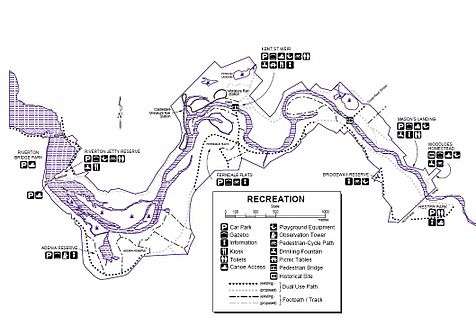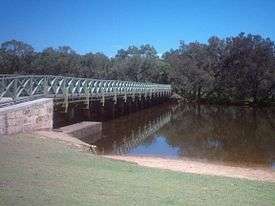Canning River Regional Park
| Canning River Regional Park | |
|---|---|
|
Kent Street Weir | |
| Type | Regional park |
| Location | Perth, Western Australia |
| Coordinates | 32°01′41″S 115°54′58″E / 32.02806°S 115.91611°ECoordinates: 32°01′41″S 115°54′58″E / 32.02806°S 115.91611°E |
| Area | 266 ha (660 acres) |
The Canning River Regional Park is the largest of eight Regional Parks within the Perth metropolitan area. The park covers approximately 6 km of the Canning River between Nicholson Rd and Shelley Bridge (Leach Hwy).[1] Canning River is a major tributary of the Swan River in south western Western Australia.
History
Aboriginal history
At the time of European settlement, the Swan and Canning basins supported a population of Australian Aborigines. At least six family groups are thought to have claimed territorial rights to the land which is now the metropolitan area.[2]
European history
The regional park encompasses an area which was once a significant river system and transport route during the colonisation of Perth. Primarily to transport logs from further south to the Swan River then Perth, Western Australia.
Over the years land use in the area included farms, orchids, brickworks, market gardens, a timber mill, recreation and a Sikh cremation site. More recently parts have been used for rubbish disposal, a museum and stock-holding area. [3][4]
Flora
Canning River Regional Park sits upon Bassendean sands.[5]
Facilities and attractions

General access
Access throughout the park is offered by either Dual Use Path or walk tracks, with the emphasis being on the enjoyment of the surrounding nature. The local council (City of Canning) and the Department of Environment And Conservation (DEC) are responsible for providing well designed recreation areas without detracting from the natural values of the Park.
Vehicle access is provided for formal parking or emergency services. The park may also be accessed by pedestrians, bicycles, boats, canoes and wheel chairs.
Unfortunately uncontrolled vehicle and pedestrian access has severely degraded some areas.
Kent Street Weir and Wilson Park
By far having the most developed parking, toilets, boat / canoe access and picnic facilities (including barbecues). There is also a "eco" center which houses historical and ecological information, as well as being the location for environmentally focussed educational activities. The river can also be crossed via the Kent St Weir Bridge, providing access to large areas of the Park. As at May 2009, the bridge was undergoing repair (but still open to pedestrians and cyclists).
Each year, Western Australia Day is an open day at the park, with exhibits, children's activities, animals, guided walks in the regional park and Western Australia Day commemoration. Many of these activities are free for all to enjoy, and make a great family activity.
Leisure activities
Every Saturday at 8am, a free 5 km timed run takes place at Canning River Regional Park. The event is known as Canning River parkrun[6]
Castledare Miniature Railway
Castledare has extensive facilities, including over 5 kilometres of track, railway station, signal box, turn table, storage sheds and workshops. There are toilets, a kiosk, and limited picnic facilities. "Run days" are usually on the first and third Sundays of the month and during school holidays.[7][8]
Mason's Landing
Have toilets, boat / canoe access and playground equipment and picnic facilities, parallel parking is provided along Duff Rd.
Riverton Bridge Reserve
Formal parking, kiosk, toilets, boat / canoe access and picnic facilities are provided here.
Ferndale Flats
Formal car park and open space are provided here.
Greenfield Bridge area
Formal parking is provided here.
Adenia Reserve
Is a large parkland area, no formal parking areas are provided but there is ample room to park on Adenia Road. It is close to the Conservation Areas.
Maintenance and conservation
Both City of Canning and DEC are responsible for sections of the park, and are responsible for maintaining the facilities and infrastructure in the area.
In order to maintain and restore the environmental values of the park, activities including weeding and revegetation (and hand watering during summer) not only carried out by paid labour, but by volunteer groups. Much of the work done in the park is by the Canning River Regional Park Volunteers consisting mostly of locals of all ages. The volunteer group's aims are to promote the Canning River Regional Park as a place of conservation and passive recreation, and to carry out activities which enhance the natural values of the area.[9][10]
Many projects are ongoing to transform the degraded sections of the park by the reintroduction of native species and providing public access in a safe and sustainable manner. Where necessary, funding for materials is often obtained through community grants from organisations such as Lotterywest, as well as corporate programs such as Alcoa.
Arson
The Canning River Regional Park is often attacked by arsonists; these attacks have become a growing problem not just for the park itself but the whole of Perth. The Arson Reward Scheme by the Arson Task Force offers informants rewards of up to $25,000 for information leading to the conviction of arsonists.[11]
See also
References
- ↑ Department of Environment and Conservation, Canning River Regional Park
- ↑ Richards, O. (1991) "Canning River Regional Park Historical Survey"
- ↑ Agar, P. (2008) "End to End, A Year in the Canning River Regional Park"
- ↑ Department of Conservation and Land Management (2007), Canning River Regional Park Management Plan No. 36, 1997-2007
- ↑ Agriculture Western Australia, Soils of the Swan Coastal Plain
- ↑ Canning River parkrun
- ↑
- ↑ Histroy of Castledare Miniature Railway
- ↑ SERCUL Canning River Regional Park Volunteers (CRRPV), CRRP Volunteers
- ↑ Canning River Regional Park Volunteers, Official CRRP Volunteers Website
- ↑ Government Media Office, Ministerial Arson in Perth's southern suburbs highlighted in discussion paper
